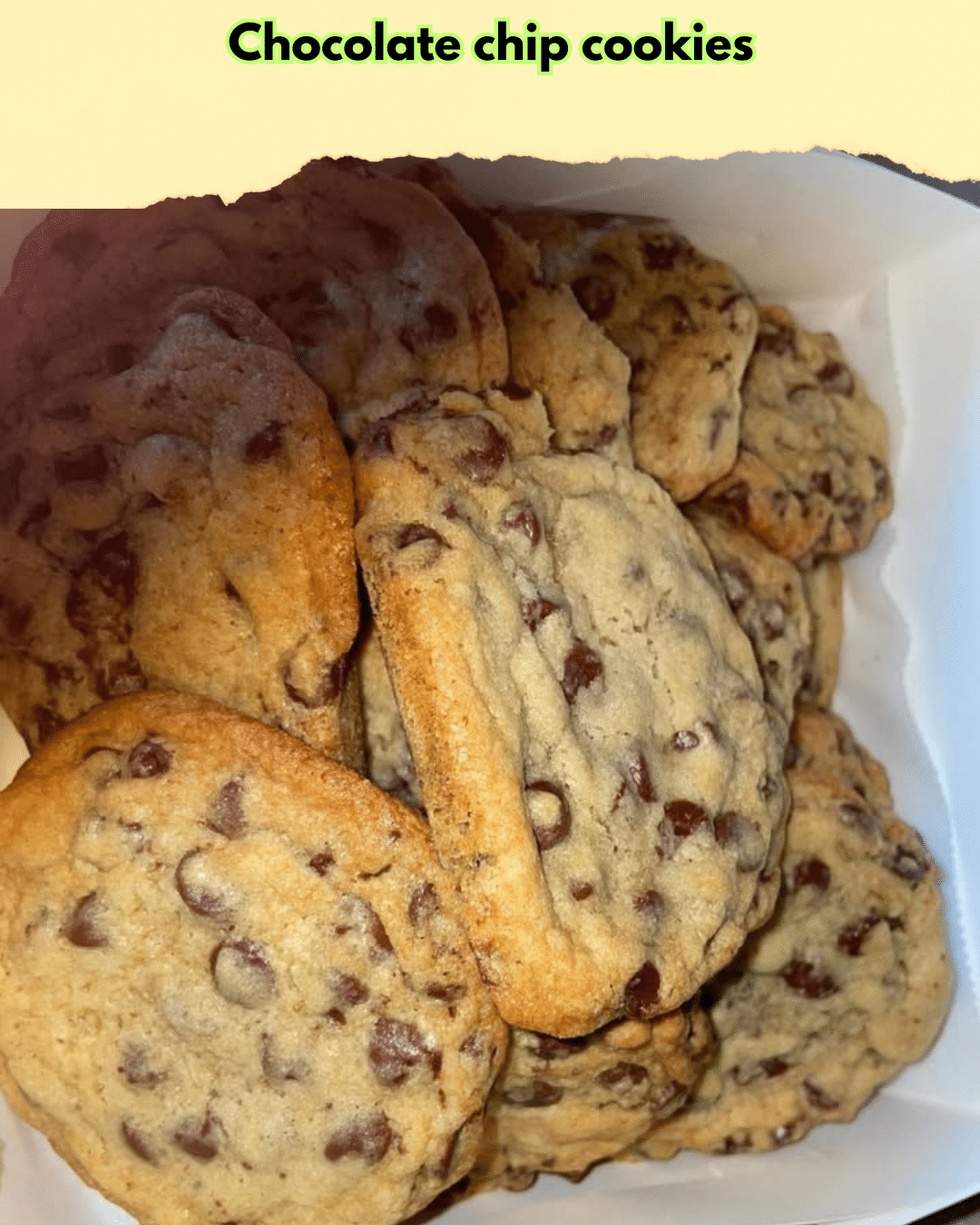Classic Chocolate Chip Cookies: The Ultimate Comfort Dessert
There’s something incredibly satisfying about biting into a homemade chocolate chip cookie, fresh off the baking sheet. These cookies are beloved for their perfect blend of crispy edges and chewy centers, filled with melting chocolate chips that make every bite irresistible. The smell alone is enough to lift spirits and warm the heart. Whether it’s a rainy day or a cozy evening, chocolate chip cookies are the go-to comfort food that people of all ages appreciate.
Making chocolate chip cookies from scratch is not only rewarding but also offers the opportunity to engage in a cherished traditional baking practice. As the cookies bake, they fill the kitchen with a rich and inviting aroma that beckons family members to gather around. These cookies are an all-time favorite, suitable for any occasion, from family gatherings to simple solo indulgences with a cup of milk or coffee.
Quick Recipe Highlights
- Flavor Profile: The rich, buttery flavor pairs beautifully with the sweetness of the brown sugar and the depth of semi-sweet chocolate chips, creating a balanced and indulgent treat.
- Texture: The perfect chocolate chip cookie should have a crispy edge that gives way to a soft and chewy center, offering a satisfying bite every time.
- Aroma: The enticing aroma of freshly baked cookies, with notes of vanilla and chocolate, envelops the kitchen and evokes nostalgia for many.
- Visual Appeal: With their golden-brown finish and generous sprinkling of chocolate chips, these cookies are a feast for the eyes even before the first bite.
- Skill Level Needed: This recipe is approachable for bakers of all levels, with simple steps that ensure a delicious outcome every time.
- Special Equipment: A stand mixer will make the creaming process of the butter and sugar much easier, though a hand mixer works just as well.
Recipe Overview
- Difficulty Level: These cookies fall into the easy category, making them a great choice for beginner bakers and a fun project for kids to help with under supervision.
- Category: Chocolate chip cookies are a quintessential dessert, often categorized as casual comfort food perfect for any season.
- Cuisine: Rooted in American culinary traditions, they have become a staple in households worldwide, beloved for their universality and simplicity.
- Cost: With their basic ingredients such as flour, sugar, and butter, chocolate chip cookies are cost-effective and budget-friendly.
- Season: While delightful year-round, they are particularly popular in cooler months when their warm, homey flavors are most comforting.
- Occasion: Perfect for any informal gathering, chocolate chip cookies also make excellent gifts or contributions to potlucks and bake sales.
Why You’ll Love This Recipe
The appeal of chocolate chip cookies lies in their timeless flavor and texture, highlighted by the melty chocolate and a balance of sweet and buttery notes. Conveniently prepared in under an hour, this recipe is perfect for those spontaneous sweet cravings. The cookies pack well into lunch boxes or are ideal for sharing during a picnic or a cozy movie night.
Despite their indulgent nature, these cookies also offer some nutritional advantages. By using dark chocolate chips, you can add healthful antioxidants, while choosing organic or unrefined sugars provides slight nutritional benefits over traditional refined options. Additionally, the recipe is versatile, allowing for ingredient swaps that cater to different dietary needs, making it both inclusive and adaptable.
The social value of chocolate chip cookies should not be underestimated. Sharing a batch can bring people together, serving as a sweet token of appreciation or a warm welcome. They are often seen as an ice-breaker at gatherings, sparking conversations about childhood memories and baking stories.
Not only are these cookies accessible and easy to make, but they’re also incredibly cost-effective. The ingredients are basic pantry staples, enabling quick preparations from ingredients you likely already have at home, reducing the need for special trips to the grocery store.
Historical Background and Cultural Significance
The humble beginnings of the chocolate chip cookie date back to the 1930s in the United States when Ruth Wakefield of Whitman, Massachusetts, serendipitously created them at the Toll House Inn. Intended to be a simple addition to her butterscotch ice cream recipe, the semi-sweet chocolate bits didn’t melt completely, leading to the first batch of cookies that were crisp on the outside and chewy on the inside, a texture still revered today.
Culturally, chocolate chip cookies have become an American household staple, often associated with home baking and family traditions. Their popularity surged post-World War II when GI’s, having tasted these cookies during their deployment, requested them upon returning home, solidifying their place in American culinary history.
The recipe for chocolate chip cookies, like many classic recipes, has evolved over time. Original instructions were less precise than today’s standard metric measures, leading to variations that reflect regional tastes and ingredient availability. From adding nuts to using different types of chocolate, these cookies continue to adapt to modern palates while maintaining their original charm.
Variations abound depending on the region, with some areas preferring crispy cookies while others lean towards thicker, softer versions. The result is a diverse range of interpretations, ensuring that there’s a chocolate chip cookie out there for every taste preference.
Ingredient Deep Dive
Butter is a cornerstone ingredient in chocolate chip cookies, contributing to their tender crumb and rich flavor. Historically, butter has been a symbol of wealth and hospitality across cultures. Its high fat content lends these cookies their characteristic mouthfeel. When selecting butter, opt for unsalted to control the overall salt balance in the cookie dough. Store butter in the refrigerator to maintain its freshness, and bring to room temperature before use for easy creaming.
Chocolate, particularly semi-sweet or dark, gives these cookies their signature flavor. Rich in antioxidants, chocolate also provides depth and a slightly bitter counterpoint to the sweetness of the dough. Choose high-quality chocolate for the best flavor, and store in a cool, dry place. While semi-sweet is classic, feel free to experiment with dark, milk, or even flavored chocolates for a personal touch.
Flour serves as the structure for the cookies, with all-purpose being the most common choice. Flour’s origins vary globally, but its role as a fundamental baking ingredient is universally acknowledged. Ensure freshness by storing flour in an airtight container in a cool, dry place. For those with dietary restrictions, gluten-free flour blends can often be substituted successfully.
Common Mistakes to Avoid
- Overmixing the Dough: This can lead to tough cookies due to gluten formation. Mix just until the ingredients are combined.
- Using Cold Butter: Cold butter can result in uneven dough and inconsistent texture. Ensure the butter is softened before use.
- Skipping the Chill: Chilling the dough before baking helps prevent spreading and enhances flavor, so don’t skip this step.
- Inaccurate Measurements: Baking is a science, so use measuring cups and spoons for precision, especially with flour and sugar.
- Ignoring the Oven Temperature: Make sure the oven is fully preheated before baking to ensure even cooking.
- Using Stale Ingredients: Check the freshness dates on your baking staples to ensure the best results.
- Not Allowing for Spread: Space cookies adequately on the baking sheet to prevent them from merging into one another.
- Uneven Sizing: Use a cookie scoop to ensure each ball of dough is the same size for uniform baking.
- Opening the Oven Door Frequently: This can cause heat loss and uneven cooking.
Essential Techniques
Creaming Butter and Sugar: This step is crucial for creating a light and tender texture in your cookies. Proper creaming incorporates air into the batter, which expands in the oven to give cookies their characteristic rise and fluffiness. Pay attention to the color and texture of the mixture; it should be pale and fluffy before you proceed to add the remaining ingredients.
Perfectly Perfect Baking: Keep a close eye on your cookies towards the end of the baking time. They should be golden brown on the edges and slightly undercooked in the center. Remember, cookies continue to cook on the baking sheet after being removed from the oven, preventing over-baking keeps them chewy.
Pro Tips for Perfect Chocolate Chip Cookies
Start with quality ingredients. Fresh, good-quality butter, chocolate, and vanilla can make a significant difference in flavor. Consider using a mix of chocolate chip sizes or types for varied texture and taste, such as a combination of mini chips and chunks.
Chill the dough for at least 30 minutes before baking. This not only prevents excessive spreading but also helps the flavors meld together for a more harmonious cookie.
Always preheat your oven and line baking sheets with parchment paper or silicone baking mats to prevent sticking and promote even baking.
Experiment with salt levels in the dough. A touch of extra sea salt can elevate the depth of chocolate flavors and provide a pleasant contrast to the sweetness.
Remember to rotate baking sheets halfway through. This ensures even baking, especially if your oven has hotspots or uneven heat distribution.
Variations and Adaptations
Experiment with regional variations by adding chopped nuts, such as walnuts or pecans, for added texture and flavor. Seasonal adaptations are also easy; try incorporating pumpkin spice in the fall or peppermint extract during the winter holidays for a festive twist.
For those following specific diets, consider using dairy-free butter substitutes or gluten-free flour blends. Adjust the sugar content for those reducing their calorie intake or search for low-sugar chocolate options like stevia-sweetened chips.
Add a flavor twist by incorporating citrus zest, a splash of espresso, or even a bit of cinnamon for an unexpected depth to your cookies. To change the texture, you can include oatmeal, raising the fiber content and making the cookie chewy and satisfying.
Serving and Presentation Guide
When it comes to plating, opt for a simple white dish to let the golden-brown cookies stand out. For garnishing, sprinkle a pinch of sea salt or even extra chocolate chips on the cookies right out of the oven.
Traditionally, these cookies pair perfectly with a glass of milk or warm cup of coffee. For a modern presentation, serve alongside a scoop of vanilla ice cream or drizzle with a homemade caramel sauce.
Ensure cookies are served at the optimal temperature, slightly warm, to appreciate the melting chocolate and aroma. Keep portions in check by using a standard cookie scoop to ensure each cookie is approximately the same size.
Wine and Beverage Pairing
Pair these cookies with a light-bodied red wine such as Pinot Noir, which complements the chocolatey richness without overwhelming it. For those seeking non-alcoholic options, a cold glass of milk or rich hot chocolate can intensify indulgence.
For coffee lovers, a bold espresso pairs perfectly, enhancing the chocolate’s depth. Temperature is key; chilled or warm drinks enhance the cookie’s sensory experience, depending on preference.
Storage and Shelf Life
To keep cookies fresh, store them in an airtight container at room temperature for up to a week. Consider layering wax paper between cookies to maintain their texture. If you notice staleness, they may be reheated briefly in a low oven to refresh.
For longer storage, these cookies freeze well. Place them in a sealed bag or container, and they’ll maintain quality for up to three months. To enjoy, simply allow them to thaw at room temperature or warm them in the oven.
Make Ahead Strategies
Plan your prep by mixing the dough in advance. It can be refrigerated for up to 72 hours, allowing flavors to develop more richly. Before baking, let the dough sit at room temperature for a few minutes for easier scooping.
Store each component of the cookies separately, such as pre-measuring dry ingredients, to streamline preparation. Reheat baked cookies in the oven briefly for a fresh-from-the-oven experience.
Fresh elements such as additional chocolate chips or sea salt can be added just before baking to keep flavors vibrant and unique each time.
Scaling Instructions
For smaller batches, simply halve the ingredient quantities, taking care with measurements for precision, especially with baking soda and salt. Similarly, if doubling or tripling the recipe, ensure your mixing bowl can accommodate larger quantities.
Invest in a kitchen scale for accurate ingredient adjustments, which reduces conversion errors. Adjust baking times slightly, monitoring closely when scaling up or down, as cookies may bake faster or slower based on oven load.
Consider storing extra dough in the freezer, portioned into cookie-sized balls, for convenient future use when cravings strike.
Nutritional Deep Dive
These cookies comprise a balanced blend of carbohydrates, fats, and sugars. Recognizing macro distribution helps moderate consumption as part of a balanced diet. Chocolate provides beneficial antioxidants, while flour offers a source of energy.
Be mindful of portion sizes, aiming for one or two cookies to maintain calorie intake. For those tracking dietary macros, consider incorporating whole grain flour or reduced-sugar chocolates to adjust nutritional profiles accordingly.
Dietary Adaptations
For a gluten-free version, select a reliable gluten-free flour mix that accommodates cup-for-cup substitutions. Opt for dairy-free margarine and chocolate chips to craft a lactose-free version, ensuring inclusivity.
Vegan adaptations are straightforward, using plant-based butter substitutes and egg replacements like flaxseed meal or chia seeds. To lower carbs, almond flour can replace conventional flour, though textural differences will occur. Other dietary modifications may include using sugar alternatives for low glycemic index variants.
Troubleshooting Guide
If your cookies spread too much, chilling the dough and ensuring correctly softened butter can mitigate issues. Balanced flavors can be achieved by adjusting vanilla or salt levels if cookies lack depth or complexity.
Uneven baking might arise from inconsistent dough sizing or oven hotspots, both solvable by using a cookie scoop and rotating trays as needed. Substituting ingredients wisely, such as using gluten-free or alternative sugars, can maintain cookie integrity while catering to diverse diets.
For timing concerns, trial and error with bake times under new equipment conditions or when using larger quantities is critical to achieving desired results.
Recipe Success Stories
Readers continuously report back with joyous tales of cookie success, from stress-free baking with kids to creating beloved holiday gifts. Community feedback frequently emphasizes the recipe’s reliability and adaptability to dietary needs without sacrificing taste.
Photography enthusiasts might experiment with lighting and styling, showcasing their golden-brown creations against colorful backdrops or rustic wooden tables for an eye-catching presentation.
Frequently Asked Questions
Yes, you can freeze cookie dough in individual balls on a baking sheet before transferring them to an airtight container. This makes it easy to bake fresh cookies on demand.
Why are my cookies flat?
Flat cookies often result from dough that’s too warm or insufficient baking soda. Ensure the dough is chilled and ingredients are fresh for the best texture.
Can I substitute baking powder for baking soda?
Baking soda requires an acid to activate, unlike baking powder. They’re not interchangeable at the same ratios, so adjustments are necessary for correct rise.
What is the best way to store cookies?
Store cookies in an airtight container at room temperature, layering with parchment to prevent sticking. To maintain chewiness, a small piece of bread can be placed in the container to keep moisture in.
How do I make chewy cookies?
Achieving chewy cookies often relies on the right balance of sugar types and slightly under-baking them, preserving moisture post-oven.
Can I use margarine instead of butter?
While possible, the flavor profile and texture may vary slightly. Ensure margarine is stable at room temperature to mimic butter’s properties closely.
How do I know when they’re done?
Cookies should be lightly golden at the edges and soft in the center, hardening upon cooling.
Can I use different types of chocolate?
Absolutely, feel free to mix chocolate varieties like milk, white, or even bittersweet to your preference and desired flavor profile.
Why is it important to chill the dough?
Chilling the dough helps solidify the fat, reducing spread and promoting a more controlled bake for a chewier cookie.
Is it okay to bake on a humid day?
Yes, but humidity can impact dough texture. Consider increasing flour slightly if the dough feels overly sticky.
Additional Resources
Explore a variety of baking resources to enhance your culinary skills, such as technique guides that delve into perfecting cookie textures or ingredient insights to understand flour types and chocolate brands.
In addition, seasonal recipe adaptations can inspire fresh ways to enjoy this classic cookie throughout the year, catering to taste trends or holiday themes. High-quality baking equipment recommendations can also assist in achieving consistent results while having a profound impact on the overall baking experience.
Print
Chocolate Chip Cookies
Description
Delicious homemade chocolate chip cookies that are crispy on the outside and chewy on the inside.
Ingredients
For the Crust:
- 1 cup unsalted butter, softened
- 1 cup brown sugar
- 1/2 cup granulated sugar
- 2 teaspoons vanilla extract
- 2 large eggs
- 2 1/4 cups all-purpose flour
- 1/2 teaspoon baking soda
- 1 teaspoon salt
- 2 cups semisweet chocolate chips
Instructions
1. Prepare the Crust:
- Preheat the oven to 350°F (175°C) and line a baking sheet with parchment paper.
- In a large bowl, cream together the butter, brown sugar, and granulated sugar until smooth. Beat in the eggs one at a time, then stir in the vanilla.
- Combine the flour, baking soda, and salt; gradually blend into the creamed mixture. Stir in the chocolate chips by hand using a wooden spoon.
- Drop cookie dough 1/4 cup at a time onto the prepared baking sheet. Leave 3 inches between each cookie.
- Bake for 15 to 17 minutes in the preheated oven, or until the edges are nicely browned. Cool on baking sheets for a few minutes before transferring to wire racks to cool completely.
Notes
You can customize the seasonings to taste.




